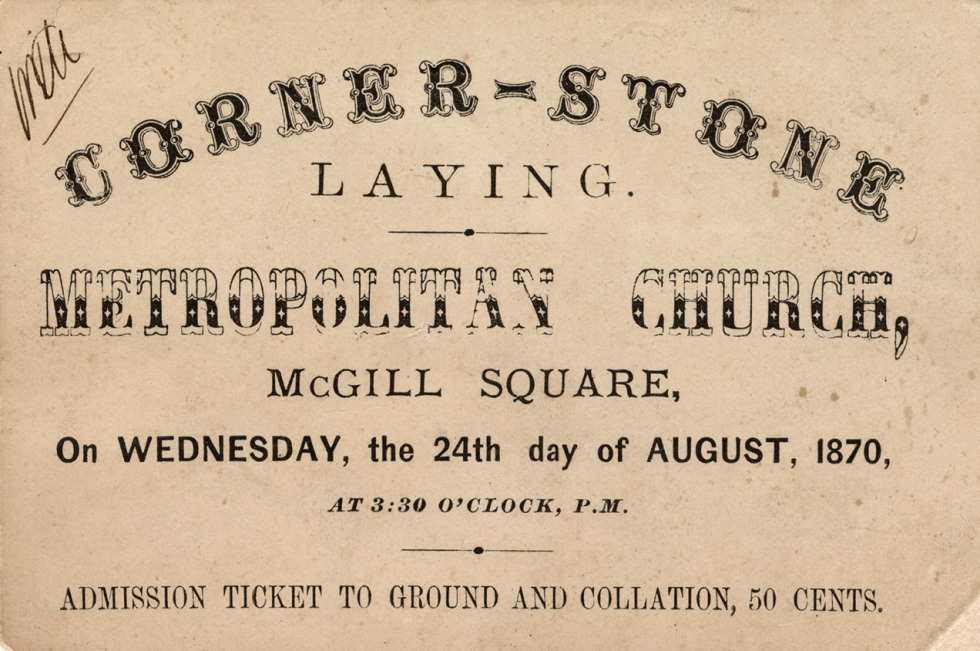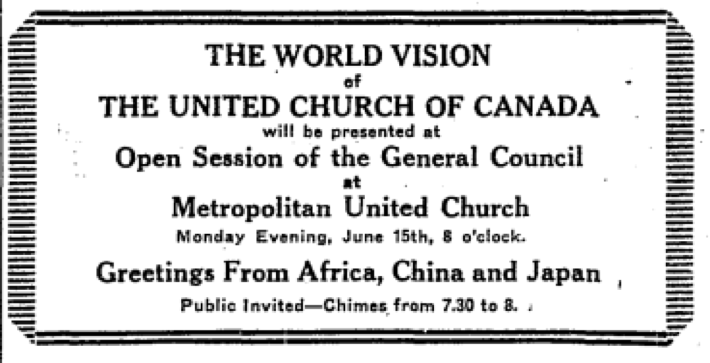Metropolitan United Church is in the heart of Toronto, serving a diverse congregation drawn from across the city and around the world. The richness of our 200+year history is complemented by our progressive vision of the future. We are an Affirming church and welcome everyone, inclusive of faith, race, class, gender, sexual orientation, or ability.
Modest Beginnings

The over 200-year history of Metropolitan United Church began in 1818 in York, what is now downtown Toronto. The first building to house the congregation was a small Methodist chapel located on King Street. Membership grew along with the city's population, so in 1831 the church acquired another site on Adelaide Street. In 1833, the Newgate Methodist Episcopal Church, a Georgian-style building accommodating 1,000 people, was opened. The church continued to grow.
The Church Moves to its Present Home

In 1868, the church trustees purchased the present-day square-block property at McGill Square (Queen and Church Streets). The congregation voted to construct a new church, renamed the Metropolitan Wesleyan Methodist Church, and dedicated it in 1872. Designed by architect Henry Langley in the Neo-Gothic style, the new building seated 1,800 (2,400 when packed for holidays), had a choir of 300 singers, and was described as Canada's "cathedral of Methodism."
This grand church had an interior with a central pulpit, side aisles, and balconies on all three sides. The chancel was very large to accommodate the enormous choir. In 1922, a carillon of 23 bells was installed in the bell tower—the largest harmonically tuned carillon in North America. Today the carillon has 54 bells. The photograph to the right shows the wonderful painted arches and the general layout of the interior of the church.
Serving the Community

After World War I, Metropolitan became involved in social service for its neighbours in downtown Toronto. Long before there was any public welfare, Metropolitan hired a social worker to coordinate programs for the poor. Metropolitan's famous minister Peter Bryce was able to convince the publisher of the Toronto Star newspaper to create a special Christmas program for poor families. The program began with a few hundred dollars in donations; today the Star Santa Claus fund raises over a million dollars every year.
The Unification of the Churches

As Canada expanded, the Congregational, Methodist, and Presbyterian churches had trouble finding enough ministers to serve in the many churches that dotted western Canada. To deal with that issue, the Methodists, Congregationalists and most Presbyterians joined to form the United Church of Canada in 1925. Toronto's Metropolitan Wesleyan Methodist became Metropolitan United Church. Metropolitan was chosen as the site of the first General Council of the United Church that same year.
Fire and Reconstruction

In 1928, a fire began in the early morning and ultimately destroyed most of the church building. Only the bell tower was saved because it had no direct connection to the church itself. For a year, the congregation met in nearby Massey Hall while debating whether or not to abandon the downtown site and merge with one of the other United churches in Toronto. The decision was finally taken to build another Gothic church on the foundations of the old one. Metropolitan United was rescued from possible destruction for the first time. The new church opened with great fanfare in December 1929. Only six of the stained glass windows were in place and the organ was not installed until the following year, but the new church was an immediate success. With just a single balcony, Metropolitan’s new seating capacity could only accommodate 900 people, not nearly enough for the very popular evening services. With the popularity of the Christmas and Easter services, admission was by ticket only.
A Church Known for its Music
In 1930, a new organ—the largest in Canada, with 7,200 pipes—was installed in the rebuilt church. The five-manual instrument has been updated and restored over the years, with the original console retained. The organ now has 8,233 pipes, with the largest measuring 32 feet in height and the smallest the size of a pencil. In 1998, a gallery organ was added. During the 1930s and 1940s, Metropolitan developed many of the musical programs for which it is now famous - the Silver Band, the concert series, and the outstanding choirs.
Saving the Church for the Second Time

Metropolitan United remained a very popular church through the 1950s with some 1,200 members and adherents. It was the first church to broadcast Sunday sermons (on CFRB) with a "radio ministry" of many thousands of families. In the 1960s, with church attendance in steep decline, Metropolitan saw its membership base shrink very rapidly. In 1970, a report to the Trustees recommended demolishing the church building and selling the land. When put to a vote, the report was rejected by the congregation and Metropolitan was saved from destruction for the second time in its history.
A Modern Outlook for a Historic Church
In the 1970s and 1980s, Metropolitan began rebuilding its congregation for a new generation as part of a revitalized downtown Toronto. On May 16, 1999, the congregation of Metropolitan United Church voted to be recognized as Affirming: welcoming all people regardless of their sexual orientation to worship and minister among us.
Metropolitan United Church now serves a unique congregation drawn from throughout the City of Toronto, and thanks to a state-of-the-art livestream system, from around the world.

The extensive facilities in the main church building serve the spiritual and educational needs of worshippers and are also used throughout the year for community service programs. These provide assistance and activities to minister to the body, mind and spirit of people in downtown Toronto.
Recommended History Book - available from our Flanders Library!
Firm Foundations: A Chronicle of Toronto's Metropolitan United Church and Her Methodist Origins, 1795-1984, by Judith St. John, published in 1988.



